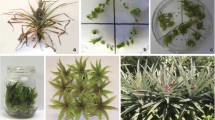Abstract
A protoplast isolation protocol was developed for kenaf (Hibiscus cannabinus L.) leaf tissue from potted plants. The kenaf protoplast system was further established to support replication of Hibiscus chlorotic ringspot virus (HCRSV). Kenaf protoplasts were isolated using 0.8% cellulase and 0.5% macerase digestion for 16 h at 25°C. Average yields ranged from 2×105 to 1×106 protoplasts g–1 fresh leaves. After polyethylene glycol-mediated transfection with in vitro transcripts of HCRSV full-length cDNA clone p223, time-course analysis showed synthesis of a genomic RNA and two sub-genomic RNAs 1 and 2 in the protoplasts. The optimal RNA concentration for the infection assay was 4 µg per 4×105 protoplasts. Western blot showed the presence of a coat protein synthesized 72 h post transfection. This kenaf protoplast system serves as a tool for in vivo studies of replication processes of HCRSV.
Similar content being viewed by others
Author information
Authors and Affiliations
Additional information
Electronic Publication
Rights and permissions
About this article
Cite this article
Liang, X., Ding, S. & Wong, S. Development of a kenaf (Hibiscus cannabinus L.) protoplast system for a replication study of Hibiscus chlorotic ringspot virus. Plant Cell Rep 20, 982–986 (2002). https://doi.org/10.1007/s00299-002-0435-2
Received:
Revised:
Accepted:
Published:
Issue Date:
DOI: https://doi.org/10.1007/s00299-002-0435-2




